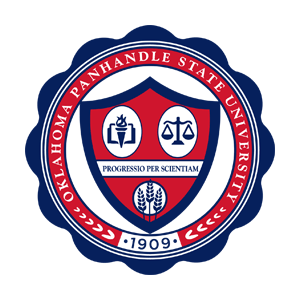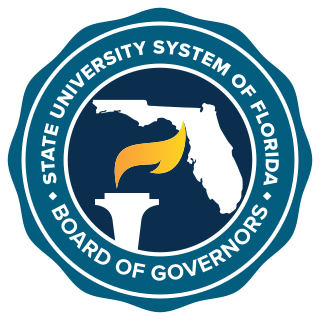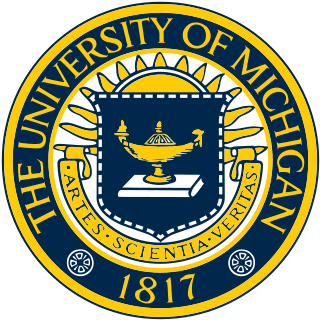
The California State University is a public university system in California, and the largest public university system in the United States. It consists of 23 campuses and seven off-campus centers, which together enroll 457,992 students and employ 56,256 faculty and staff members. In California, it is one of the three public higher education systems, along with the University of California and the California Community Colleges systems. The CSU system is officially incorporated as The Trustees of the California State University, and is headquartered in Long Beach, California.

The Universities of Wisconsin is a university system of public universities in the U.S. state of Wisconsin. It is one of the largest public higher-education systems in the country, enrolling more than 160,000 students each year and employing approximately 41,000 faculty and staff statewide. The system is headquartered in the state capital of Madison.

The University of Hawaiʻi System is a public college and university system in Hawaiʻi. The system confers associate, bachelor's, master's, and doctoral degrees through three universities, seven community colleges, an employment training center, three university centers, four education centers, and various other research facilities distributed across six islands throughout the state of Hawaii in the United States.

The University of the State of New York is the state governmental umbrella organization that oversees all educational institutions, including schools, libraries, and museums in New York State. It is governed by the Board of Regents.

Oklahoma Panhandle State University is a public college in Goodwell, Oklahoma. OPSU is a baccalaureate degree-granting institution. General governance of the institution is provided by the Board of Regents of the Oklahoma Agricultural and Mechanical Colleges. Academic programs and financial support are authorized and coordinated through the Oklahoma State Regents for Higher Education.

The University of Central Oklahoma (UCO) is a public university in Edmond, Oklahoma, United States. It is the third largest university in Oklahoma, with almost 13,000 students and approximately 430 full-time and 400 adjunct faculty. Founded in 1890, the University of Central Oklahoma was one of the first institutions of higher learning to be established in what would become the state of Oklahoma, making it one of the oldest universities in the southwest region of the United States. It is home to the American branch of the British Academy of Contemporary Music in downtown Oklahoma City.

The University of Houston System is a public university system in the U.S. state of Texas, comprising four separate and distinct universities. It also owns and holds broadcasting licenses to a public television station (KUHT) and a public radio station (KUHF).
The Florida Board of Regents was from 1965 to 2001 the governing body for the State University System of Florida, which includes all public universities in the state of Florida, United States. It was created to replace a predecessor body called the Florida Board of Control, which had existed from 1905. Its powers are now held by the Florida Board of Governors.

The Florida Board of Governors is a 17-member governing board that serves as the governing body for the State University System of Florida, which includes all public universities in the state of Florida.

The University of Science and Arts of Oklahoma (USAO) is a public liberal arts college in Chickasha, Oklahoma. It is the only public college in Oklahoma with a strictly liberal arts–focused curriculum and is a member of the Council of Public Liberal Arts Colleges. USAO is an undergraduate-only institution and grants bachelor's degrees in a variety of subject areas. The school was founded in 1908 as a school for women and from 1912 to 1965 was known as Oklahoma College for Women. It became coeducational in 1965 and today educates approximately 800 students. In 2001, the entire Oklahoma College for Women campus was listed as a national historic district.
The Illinois Community College System consists of 39 public community college districts, composed of 48 community colleges and one multi-college center where 3 of the community colleges offer additional classes. Thirty-seven of the districts have a single college; two districts are multicollege. Since July 1990, the entire state has been included within community college district boundaries.

Murray State College is a public community college in southcentral Oklahoma with the main campus located in Tishomingo, Oklahoma. It is named in honor of former Oklahoma Governor William H. "Alfalfa Bill" Murray.
The University Center of Southern Oklahoma is a consortium-model higher education delivery system which provides academic degree programs from four participating institutions of higher education located in southern Oklahoma. Freshman through graduate courses are offered and students can earn college credits for the purposes of transfer to another college, or students may complete their degree program on-site.
The history of the University of Wisconsin–Milwaukee dates back to 1885, when the Milwaukee State Normal School opened for classes at 18th and Wells in downtown Milwaukee.
Washington State University Spokane, branded as WSU Health Sciences Spokane, is a campus of Washington State University located in Spokane, Washington. It was established in 1989 and, as of 2010, is designated as the university's health science campus. The urban campus is housed on the 48-acre (19 ha) multi-institutional WSU Health Sciences Spokane campus, formerly known as the Riverpoint Campus, in Spokane's University District just east of Downtown Spokane.

The Regents of the University of Michigan, sometimes referred to as the Board of Regents, is a constitutional office of the U.S. state of Michigan which forms the governing body of the University of Michigan, University of Michigan–Flint, and University of Michigan–Dearborn.
The Oklahoma State System of Higher Education is the state's legal structure for providing public education at the collegiate level. It is a coordinated system of colleges and universities located throughout the state.

Carolyn Thompson Taylor is an American academic and politician who served in the Oklahoma House of Representatives from 1984 to 1992. Before running for office, Taylor taught AP government at Norman High School from 1979 to 1984. While in the House, she was chair of the Education Committee and Appropriations Sub-Committee on Education. She was a principal author of numerous landmark education bills involving both higher education and public schools. She also authored legislation concerning health care for children and family leave. While in office she was an adjunct professor at Oklahoma Baptist University and the University of Oklahoma. After leaving office, Taylor was vice president of academic affairs at the University Center of Tulsa and later a distinguished professor of political science at Rogers State.
Education in Utah has a long history that has led to a more efficient education system throughout the state.













